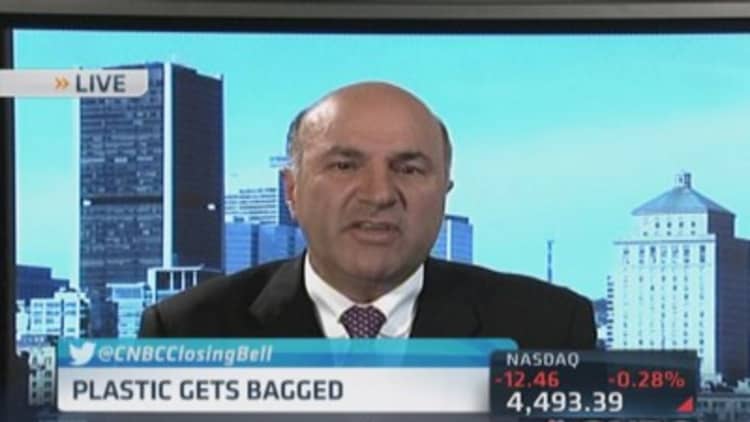Imagine walking along a beach ... and picking up a handful of littered plastic bags every step. Dystopian it may seem, but it's a pretty clear image of how much garbage is falling into the oceans every year, according to new research.
Somewhere between roughly 5 million and 13 million metric tons of plastic trash are drifting into the sea annually—enough plastic to make five grocery bags for every foot of coastline on Earth, researchers said in a study published Thursday in the journal Science.
And worse, they said, the number will increase by 2025, killing off marine life, infecting seafood with toxic materials and making the ocean a place more hostile to life.
In short, the world has become more plastic, and we are having a difficult time managing it. Plastic resin producers manufactured 300 million metric tons of the stuff in 2012, a 620 percent increase since 1975.
Previous studies have attempted to quantify the total amount of trash in the oceans, but have focused on the trash collecting in oceanic "gyres"—vast areas of slowly swirling currents in which trash seems to spin endlessly. The new study, which received support from the Ocean Conservancy, is the first attempt to estimate the total amount of trash falling into the oceans from coastal areas.
Read MoreHospitals cut costs with 'creepy' robots
The scientists who produced the study say we may have drastically underestimated the amount of plastic waste sitting in the sea. Many estimates of what is floating in the oceans number in the thousands, up to roughly 270,000, metric tons based on counts of garbage found in the gyres. The new study says that number is probably a fraction of the full picture—there are millions of tons of missing garbage somewhere in the sea.
The scientists began with World Bank data listing the amount of waste generated by each person in various countries. Using coastal population figures for the 192 countries bordering oceans, they calculated the amount of waste likely to seep into the ocean from both litter and trash that has just been stored poorly. They accounted for the effect of storms and weather on trash, and for population growth and increases in the amount of plastic used—which they expect to climb.

The researchers said that plastic makes up only about 10 percent of the total waste produced in coastal countries. Still, that is a 10-fold increase since 1960.
Plastic is especially resilient to degradation—it does not chemically break down but it does eventually fragment into tiny pieces that will remain in the oceans for a long time.
Read More
These "microplastic" particles may be more likely to catch in the bodies of marine life. Plastics that land in the bodies of whales eventually lead them to slow, painful deaths.
Plastics can be made with toxic additives, and they can act as sponges for toxins already present in water—such as DDT and PCBs, said oceanographer Kara Lavender Law of the Sea Education Association. If fish and other sea life somehow ingest those particles, toxic chemicals can build in their bodies, including within animals that humans eat.
How can we collect plastic from the ocean floor when the average depth of the ocean is 14,000 feet?Roland GeyerUC, Santa Barbara researcher
The tiny size of microparticle plastic also makes it ever more difficult to detect—possibly lower historical estimates—and tougher to detect. The team is skeptical that there are any feasible collection strategies for what has already leaked into the ocean.
"How can we collect plastic from the ocean floor when the average depth of the ocean is 14,000 feet?" asked researcher Roland Geyer of the University of California, Santa Barbara.
The countries releasing the most trash into the oceans have long coastlines and large populations, as one might expect. But middle-income countries that have lately seen fast economic growth—including China, Indonesia and Brazil—account for 16 of the top 20 producers. The top five countries—China, Indonesia, Philippines, Vietnam, and Sri Lanka—account for roughly half of the total among top 20 countries.
"This isn't about pointing fingers at certain countries," lead researcher Jenna Jambeck of the University of Georgia told CNBC in a phone interview. "I am sure if you looked back a half century or so, the biggest waste generators would be other countries. Waste generation is coupled with economic growth—as you grow you produce more waste."
Read MoreThe exploding tech sector that puzzles Wall Street
Many of the top producers also do not have adequate waste management systems in place, the study said.
The United States barely makes the list, coming in 20th place. Taken as a whole, the European Union would rank a couple of places ahead, in 18th place.
The scientists were quick to note that all their data are only estimates, and they pointed out that, for example, their numbers do not include plastic trash that comes from maritime vessels.
But the team was confident enough in its findings to suggest that if the top 20 countries improved plastic disposal by 50 percent, the total mass of newly plastic waste would decrease by almost half by 2025.
"Humans have a long track record of causing large environmental problems, but we are starting to build a track record of solving them," Geyer said.


